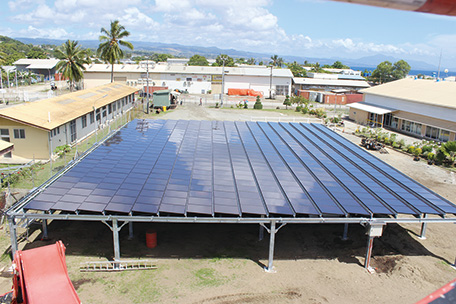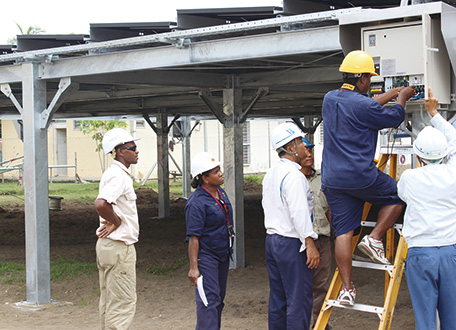Master Techniques, From Japan to the World 5
Converting an Island Nation’s Sunshine to Electricity
- High Hopes in the Solomon Islands for Okinawan Photovoltaic Generation Technology

A solar power generation system installed in a parking lot of the Solomon Islands Electricity Authority (SIEA). (Photo: Okinawa Kobori Denki Co., Ltd.)
The Solomon Islands is an island nation comprised of around 100 small islands found in the South Pacific Ocean. The country depends on diesel for nearly 100% of its electricity. However, there is concern that the resultant CO2 emissions are worsening the effects of climate change. Additionally, the oil needed to power these diesel generators is imported from overseas. The country is therefore exposed to soaring global prices, which in turn makes it difficult to secure stable supplies of electricity. As a result, the Government of the Solomon Islands announced a policy shift, aiming to generate 50% of its power from renewable sources by the year 2020.
With its large amount of sunlight, the Solomon Islands provides ideal conditions for introducing photovoltaic generation. Photovoltaic generation systems have already been installed at public facilities, including the country’s Parliament building. However, several problem areas have emerged. First, the Solomon Islands is susceptible to typhoons, which can damage the country’s photovoltaic generation systems. Second, the country’s current system of generators is not connected to distribution lines. Each generator operates independently, so any surplus electricity cannot be utilized elsewhere. Third, the Solomon Islands is comprised of many isolated islands, making it difficult to finely maintain the power system and carry out repair work quickly.
Okinawa Kobori Denki Ltd. is a company that builds, operates and maintains mega photovoltaic generation systems in Okinawa Prefecture. Its technologies have been identified as a potential solution for the problems in the Solomon Islands. Like the Solomon Islands, Okinawa Prefecture is an isolated chain of many islands susceptible to typhoons. Okinawa Kobori Denki possesses the know-how to design photovoltaic generation systems that are resilient against such strong winds. Also, the company has the know-how to efficiently connect the photovoltaic generation system into the regional electricity grid (using the distribution lines of electric power companies). This makes it possible to use surplus energy without letting it go to waste.

Local staff members confirm methods for inspection of power conditioners. (Photo: Okinawa Kobori Denki Co., Ltd.)
In order to examine whether their know-how could be utilized in the Solomon Islands or not, Okinawa Kobori Denki initiated a Verification Survey1 with the Private Sector for Disseminating Japanese Technologies in ODA Projects in October 2013 as part of JICA’s Partnership with Japanese Small and Medium-sized Enterprises (SMEs).2
The key is the technology to downsize power conditioners. A power conditioner connects individual generators across a regional power grid, but is always at risk of being damaged from exposure to harsh and powerful winds like those of a typhoon. Okinawa Kobori Denki has developed the technology for downsizing power conditioners for use in Okinawa. In other words, in a power system with a single large power conditioner, damage to the power conditioner can shut down the entire system. However, in a system with a number of small-capacity power conditioner (PCS), damage to any one conditioner does not affect the operation of the others, making it possible to maintain grid integrity. This is especially important for isolated islands because it can take much time to dispatch a boat to repair damages.
Okinawa Kobori Denki decided to utilize this technology in the Solomon Islands. In January 2015, five small-capacity 10 kilowatt power conditioners were used for the photovoltaic generation system built in the parking lot of the Solomon Islands Electricity Authority. This system has a total generating capacity of 50 kilowatts, roughly the same amount of electricity used by about 25 average households in Japan.
Additionally, Okinawa Kobori Denki trained local engineers to connect individual photovoltaic generation systems to the existing power grid and operate the system. The company also created a manual with the know-how needed to respond to any potential problem. The local community highly commended Okinawa Kobori Denki for its engineers’ careful responses, as well as its photovoltaic generation system built with damage-resilience, excellent power generation capacity, and waste-free power usage. As of October 2015, the photovoltaic generation system in the parking lot of the Solomon Islands Electricity Authority has been running without problems, and supplies power together with the existing diesel power generators connected to the regional electricity grid. As a result of this, the Solomon Islands is now considering installing more of these photovoltaic generation systems.
Mr. Kaoru Ikehara of Okinawa Kobori Denki explains, “First, we hope to establish a track record in the Solomon Islands, before expanding to other island nations in the Pacific. We also hope to one day use our electricity storage technologies to deliver photovoltaic generated electricity to regions where the Electricity Authority does not have a grid (distribution lines).”
Japanese technologies for the system installation and operation on remote islands are helping the Solomon Islands to improve their electricity system. Moreover, in the future they are expected to play a major role in solving the energy issues of many other island nations in the Pacific Ocean as well.
*1 A survey to verify ways to enhance a product and technology’s compatibility with a developing country and thereby disseminate the product and technology, based on a proposal from a Japanese SME.
*2 Projects aiming to achieve both the development of developing countries and the activation of the Japanese economy by utilizing Japanese SME’s excellent products and technologies through ODA.
<< Previous Page Next Page >>
Main Text | Statistics and Reference Materials | Stories from the field | Master Techniques, From Japan to the World | ODA Topics | A Journalist’s Perspective on Japan’s ODA
